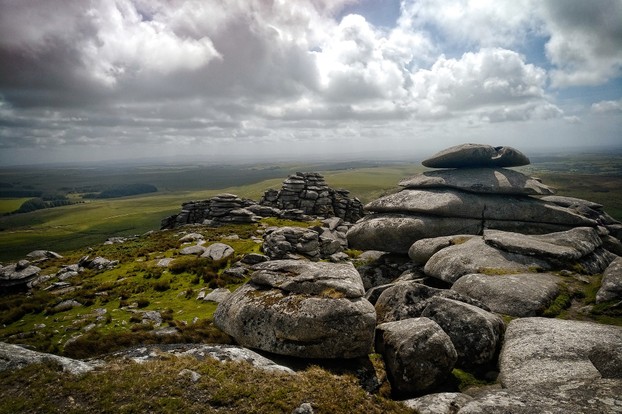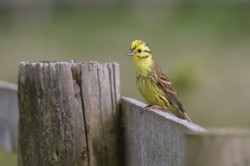The nature warden had to double check Were they seeing an illusion? But now the gnawed trees and the damn across the river Parr, which rejoices in wild turbulence into its source and destiny, the sea, in St Austell Bay, showed that their insight was correct. Beavers were back!. These pleasant creatures were not reintroduced by humans. They had been dreamed of as a future project, but beavers know nought of organisational planning. They wanted to find a place and just came. No matter that you need a license from the government to introduce beavers. They have just arrived. How they found their way is a mystery. But a nice one. No matter that the woodlands at places on the moor can be a bit scrubby, the beavers had found a home, and they had welcoming human neighbours. For a change.
Yet these rodents were not the only returnees on the ancient moor. An old British cattle breed has been introduced to run free on the moor. English longhorns .Why this breed? They are placid and unaggressive, important qualities in a beast with powerful horns. Moreover, they are tough enough to survive in wild conditions, and they derive their toughness from their ancestor, the aurochs. Some other breeds lack this toughness. Moreover, the English Longhorns can eat both grass and tree leaves, a resource known as tree hay. Longhorns use their horns to tear down branches to get the leaves. This does not harm the tree as it is a natural form of pollarding, which gives the tree vigour. Longhorn cows will happily eat a patch of nettles, for nettles, like all spiky plants are a good source of nutrients. The Longhorn's mouth is tough enough to cope with the sharpness. Thus they can digest rough pasture..
Pigs have been selected for their ability to weed ground, however rough the pasture is. The breeds chosen are so-called iron age pigs and the related breed, the Ginger Tamworth, both have snouts evolved for excavating roots. This ability makes these pig breeds able to clear an area of land far quicker than am human can. It is to be expected that the newly introduced pigs will mate with the wild pigs loose in many parts of Britain. Humans may not want this interbreeding, but we have introduced wild animals, so we cannot complain if they behave accordingly. Moreover, a wild boar can weigh 350 pounds. Now who fancies getting in the way of a 350 pound boar and his beloved?
There will be other animals which are native to the area. Badgers, which have suffered an unsuccessful cull to prevent their spreading disease to cattle will dwell safely on the moor. It is hoped that the insect fauna, including rare butterflies, such as the endangered marsh fritillary will be beneficiaries of the project. But promoting the presence of rare insects means providing habitat. The marsh fritillary, for example, has a caterpillar which can only eat the leaves of devil's bit scabious, which will grow in meadow land in late summer








 TheThousand Year Gardenon 11/26/2025
TheThousand Year Gardenon 11/26/2025
 Women of the Gospelson 10/11/2025
Women of the Gospelson 10/11/2025
 Religious Gardenson 08/25/2025
Religious Gardenson 08/25/2025
 Doctor of the Church: John Henry Newmanon 08/03/2025
Doctor of the Church: John Henry Newmanon 08/03/2025



Comments
The southern Hebrides and part of the North West
Thank you for your comment below in answer to my previous observation and question.
Your answer advises us that Scots Gaelic was "only ever a language of parts of Scotland."
What parts domiciled Scots Gaelic?
Yes. The language is not thriving, despite the nationalists attempts to foster it. But it was only ever a language of parts of Scotland.
Thank you for your comment below in answer to my previous observation and question.
That Scots Gaelic has fewer dialects than Irish Gaelic intrigues me. Is it because Scots Gaelic is spoken by fewer people and in fewer regions of Scotland?
There is discussion of this, but Scots Gaelic has fewer dIialects and there is more Norse in Scotland than in Ireland
Thank you for your comment below in answer to my previous observation and question.
The Munster dialect as the purest dialect in all Irish Gaelic and in fact in all Gaelic appeals to me as the descendant through my maternal, Norway line of ancestors there (and in fact in all areas of the Emerald Isle).
What is the purest dialect in Scots Gaelic?
Thenpurest dialect of Irish.
Thank you for your comments below in answer to my previous observations and questions.
Your answer three comment boxes down alerts us to the Munster dialect as "the pures tGaelic of all."
Is that dialect the purest of all Gaelic or just of all Irish Gaelic?
Almost all surviving cattle breeds are preserved in farms. The Rare Breeds Survival Trust takes rare farm nanimalsnand breeds them.
Thank you for your comments below in answer to my previous observation and question.
Your answer about longhorn introductions as small "flocks which preserved traditional breeds" intrigues me.
Is a longhorn flock within a traditional breed-preserving population considered as surviving in the wild or only in the non-wild?